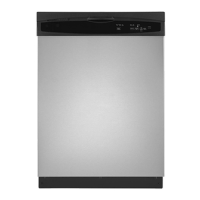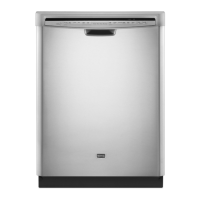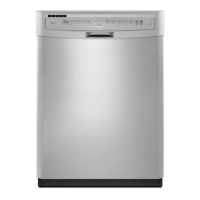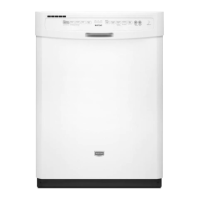For optimal cleaning and drying
results, hot water is necessary. The
incoming water temperature should be
120-140° F (49-60o C) to properly acti-
vatethe detergent and melt greasy food
soils.
Tocheck the incoming water temperature,
turn on the hot water faucet nearest the
dishwasherand let it run intoa glass in the
sink. Place a candy thermometer in the
glass and check the temperature once it
has stopped rising. If the temperature is
below 1200F (490C), havea qualifiedper-
son raise the water heater thermostatset-
ting.
Beforestartingthe dishwasher,turn on the
hot water faucet and let it run until the
water is hot.This assuresthat the initial fill
ofwater is hot.
Use a detergent designed specifically for
use in an automatic dishwasher.Be sure it
isfresh and stored in a cool, dry place(not
under the sink).
RECOMMENDEDAMOUNT
Toolittledetergent resultsin poor cleaning,
hard water filming/spotting and poor dry-
ing. Too much detergent can cause per-
manent etching/cloudiness.
The amount of detergent to use is deter-
mined by the hardness of the water and
soil levelofthe load. Referto the following
chart for detergent usage recommenda-
tions.
Do not use detergent with Rinse Only.
Leavethe detergentlid open whenrunning
Rinse Only.
In extremely hard water conditions (13
grainsper gallon or more*), it is difficult to
achievegood resultswith any dishwasher.
A mechanicalwater softener may be nec-
essaryto improve water quality, detergent
effectiveness, and protect the dishwasher
partsfrom the damagethat hard water can
cause.
Soft (0-4 gpg) Light Soil 5 teaspoons
Normal Soil 6 teaspoons
Heavy Soil 8 teaspoons
Medium (5-9 gpg) Light Soil 7 teaspoons
Normal Soil 8 teaspoons
Heavy Soil 10 teaspoons
Hard (10-12 gpg) Light Soil 9 teaspoons
Normal Soil 10 teaspoons
Heavy Soil 12 teaspoons
*Your local water utility or state uni-
versity extension service can tell you
the degree of water hardness in your
area.
** Add recommended amount of
detergent to both compartments for
AutoClean, Heavy or Normal wash
cycles, and to the main cup only for
the Light wash cycle.
;6
Regular use of a rinse aid improves
drying, reduces spotting and filming,
and reduces moisture left on the dish-
washer interior,
Your dishwasher features an automatic
rinseaid dispenser located nearthe deter-
gent cups in the door.
The clear window in the center of the dis-
penser cap allows you to see if there is
rinseaid inthe reservoir.Whenthewindow
is colored, there is rinse aid in the dis-
penser. When the window becomesclear,
it is time to refillthe dispenser. Check the
dispenser monthly.
Toadd rinse aid to the dispenser, turn the
cap counterclockwise to open. Remove
the cap and pour liquid rinse aid into the
opening.Replacethe capand turn itclock-
wise.
Use the LESS setting for soft water and
the MORE setting for hard water. Set the
cap anywhere between these amounts as
needed.
5

